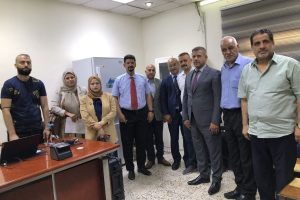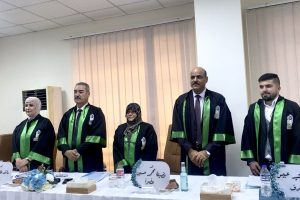
A postgraduate student from the Medical and Industrial Materials Science Branch earns a Ph.D. degree for her research on “Preparation and Study of the Structural, Optical, Mechanical Properties, and Ionizing Radiation Shielding of a Glass System.”
The Medical and Industrial Materials Science Branch awarded a Ph.D. degree to postgraduate student Saba Farhan Hathhout for her dissertation titled:
“Preparation and Study of the Structural, Optical, Mechanical, and Ionization Radiation Shielding Properties of a Glass System”
The dissertation defence took place in the late Professor Dr. Abdul-Muttalib Ibrahim Al-Sheikh Hall within the department building. The defence committee consisted of::
- Professor Dr. Ghazi Kamal Saeed – University of Wasit / College of Basic Education (Chair)
- Professor Dr. Shehab Ahmed Zidan – Applied Sciences Department / Medical and Industrial Materials Science Branch (Member)
- Professor Dr. Enas Mohi Hadi – Applied Sciences Department / Medical and Industrial Materials Science Branch (Member)
- Assistant Professor Dr. Bushra Husni Mousa – Applied Sciences Department / Medical and Industrial Materials Science Branch (Member)
- Professor Dr. Balqees Mohammed Diaa – Al-Turath University College (Member and Supervisor)
- Professor Dr. Haider Hammoud Naama – Al-Mustansiriyah University / College of Science / Department of Physics (Member)
This study aimed to prepare glass samples and convert them into glass-ceramic samples, compare their structural, optical, and mechanical properties, and evaluate their potential for radiation shielding applications.
The glass samples were synthesized using the melt-quenching method, with the composition:
(50−x)B2O3−25TeO2−25BaO−xDy2O3(50-x) B_2O_3 – 25TeO_2 – 25BaO – xDy_2O_3
Where x varied from 0 to 1.25 mol%, the prepared glass samples exhibited a yellowish transparent appearance. Characterization and Analysis: Morphological and Structural Analysis: Scanning Electron Microscopy (SEM) was used to examine the morphology of the glass samples. X-ray Diffraction (XRD) patterns confirmed the amorphous nature of all glass samples. Optical Properties: UV-Vis absorption spectra were analyzed in the 200–1100 nm wavelength range. Key optical parameters, including absorption coefficient and direct and indirect optical band gaps, were determined. Mechanical Properties: Ultrasonic wave velocity measurements were conducted at 5 MHz at room temperature to assess the mechanical behaviour of glass and glass-ceramic samples.Thermal Analysis: Differential Thermal Analysis (DTA) was performed from room temperature up to 800°C at a heating rate of 10°C/min to determine: Glass transition temperature (Tg), Onset crystallization temperature (Tx), Crystallization temperature (Tc), Melting temperature (Tm), Thermal stability range of the glass samples. Radiation Shielding Efficiency: Gamma-ray attenuation was evaluated using a sodium iodide (NaI(Tl)) detector and radioactive sources Cs-137 and Co-60. The results indicated that as the thickness of the shielding samples increased, the transmission factor decreased, leading to higher radiation protection efficiency for both glass and glass-ceramic samples.



